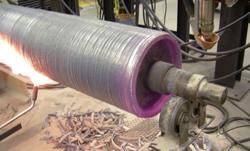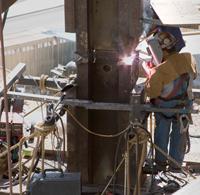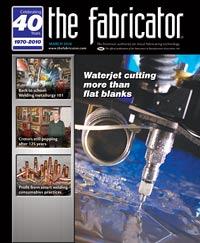Applications Engineer
- FMA
- The Fabricator
- FABTECH
- Canadian Metalworking
Categories
- Additive Manufacturing
- Aluminum Welding
- Arc Welding
- Assembly and Joining
- Automation and Robotics
- Bending and Forming
- Consumables
- Cutting and Weld Prep
- Electric Vehicles
- En Español
- Finishing
- Hydroforming
- Laser Cutting
- Laser Welding
- Machining
- Manufacturing Software
- Materials Handling
- Metals/Materials
- Oxyfuel Cutting
- Plasma Cutting
- Power Tools
- Punching and Other Holemaking
- Roll Forming
- Safety
- Sawing
- Shearing
- Shop Management
- Testing and Measuring
- Tube and Pipe Fabrication
- Tube and Pipe Production
- Waterjet Cutting
Industry Directory
Webcasts
Podcasts
FAB 40
Advertise
Subscribe
Account Login
Search
Beyond low-carbon steel
A brief, nontechnical discussion of welding metallurgy
- By Mike Barrett
- March 1, 2010
- Article
- Arc Welding

Figure 1Certain alloys, such as the high-carbon steel used in this caster roll, require sufficient preheat, which slows cooling after welding and helps prevent cracking.
The economy has pushed fabricators to adapt, market themselves to bring in new work, and even pursue untapped markets. This can bring different materials on the shop floor, and the learning curve can be steep for an entry-level welder. But one thing doesn't change: the fundamentals of weldability. When welders tackle new materials that need to be joined, they always should have weldability on their radar.
Between a Hot Crack and a Hard Place
Cutting tools have gotten expensive, as global demand forced prices of raw materials used for these consumables, including tungsten, through the roof. For this reason, manufacturers have been on a quest to use steels that are easier to machine and kinder to cutting tools than even plain carbon steel. Their goal: The faster they can machine metal and the longer cutting tools last, the better.
Unfortunately, these grades aren't necessarily kind to the welding gun. Free-machining, resulfurized steels aren't free-welding steels. In some cases, they can't be arc- welded at all. Look out for SAE steel grades 11XX and 12XX. Other metals, such as AISI 303 stainless steel, present similar welding problems. What's important here is to look at the chemical makeup, specifically the levels of sulfur and phosphorus. These two elements can lead to cracking in the center of the weld.
The problem with these metals occurs during weld solidification. Because iron sulfides (a compound formed from iron and sulfur) and phosphorus melt at lower temperatures, they're also the last to resolidify after heated with an arc. After the arc melts the weld and base metals, it starts solidifying from the fusion line inward toward the center. The iron sulfides and phosphorus are pushed to the center by the other elements solidifying at a higher temperature. This creates a weld with a centerline highly concentrated in phosphorus and sulfides, which may crack easily, especially when the residual stress from the cooling metal pulls against them.
To maintain good weldability, most carbon steels should have a phosphorous level of 0.04 percent or less and 0.035 percent or less of sulfur (though 0.04 percent may work in some applications). Free-machining, resulfurized steels, as their name suggests, go heavy on the sulfur, having anywhere between 0.08 to 0.33 percent, up to eight times the amount ideal for welding.
AISI 303 stainless steel shouldn't be welded for the same reasons: Sulfur and phosphorus are added to improve machinability. Even 303Se, which replaces sulfur with selenium for formability, has trouble with the welding gun, because selenium has a lower melting temperature that can ultimately lead to centerline cracking.
So where does this leave the welder? Sometimes between a hot crack and a hard place (so to speak). It boils down to calculating costs and running the numbers. Free-machining steels may cost less on the machining end, but the difficulties in welding them may not be worth the cost savings.
Carbon, Chromium, and Cracking
Carbon gives steel its strength, but past a certain point, high carbon content in steel makes it susceptible to brittleness and cracking after welding—especially hydrogen cracking. These delayed cracks generally form with sufficient stress (from shrinkage stresses in the weld, for example), hydrogen, and hardness. By eliminating or reducing just one of them, the welder can greatly reduce the possibility of hydrogen cracking. Still, as thickness increases, the problem generally becomes worse.
In these cases, welders can't just use a low-hydrogen consumable and call the problem solved. It goes back to some welding fundamentals. Preheat, interpass temperatures, and postweld heat treatments (PWHT) play important roles (see Figure 1), as do proper consumable handling techniques. Low-hydrogen electrodes left in open containers on a humid shop floor pick up moisture, which contains hydrogen, and this may cause problems in the weld. Low-hydrogen consumables should be stored in holding ovens to prevent them from absorbing moisture. Preheat temperature should be determined by using the carbon equivalency formula (which takes into account the weighted effects of different alloying elements) or tables in the AWS D1.1 welding code and elsewhere.
Carbon isn't the only element that can lead to cracking. Other alloying elements, such as chromium and molybdenum, can play a role. Specifically, SAE 4130 chrome-moly consisting of 0.30 percent carbon, 1 percent chromium, and 0.25 percent molybdenum can introduce cracking. Chromium and molybdenum contribute to hardenability, which makes slowing the cooling rates on these metals essential to prevent cracking. As the thickness of the 4130 steel increases, the required preheat temperatures also will increase.

Figure 2Most modern steel structures, like this one, use steel having formulations consistent enough for welding. Unfortunately, this isn't true for older structures.
More components, particularly those used in the power generation industry, require metals that endure high-temperature service. Welders are seeing more of a high-chromium steel called P91. It's lower in carbon than some of the chrome-moly steels, but the higher level of chromium and other alloying elements means it requires a certain amount of preheat and PWHT. Precipitated throughout the metal's microstructure, vanadium and niobium carnbonitrides help these metals endure high-temperature service, a material characteristic that will only be demanded more as the country upgrades its power generation infrastructure.
Old Structures, Old Steel, Same Old Problems
Steelmaking isn't what it used to be, and that's a good thing (see Figure 2). Before welding really took off in the 1940s, steelmakers didn't take welding into account, so the chemical makeup of these metals was far from consistent.
This is why problems may arise when welders are called to repair or modify buildings constructed before World War II. The materials' chemical composition makes these metals a unique breed. Call it "old steel."
Such steels can have high sulfur and phosphorus levels, which again lead to those centerline cracks. These steels have inconsistent metallurgical makeups, they're often full of impurities, and their chemistries can change from one area to the next. So, truth be told, there really isn't an ideal welding solution.
Of course, welders are known for "making it work." They sometimes try an E7018 stick electrode. The consumable's slag system—the electrode's coating that protects the weld—helps take care of some of the problems related to metal impurities. It's a low-hydrogen electrode, and it can help prevent some porosity issues brought about by high sulfur content. Also, E7018 tends not to penetrate as much into base material as other electrodes. Less penetration means the welder can minimize the amount of mixing between the base and weld metals, which makes cracking less likely.
Weldability tests can determine if the existing structure can be welded on. Information on weldability testing on structures can be found in AWS D1.7, "Guide for Strengthening and Repairing Existing Structures."
Cast-Iron Issues
Repair welding continues in full force in this economy, as companies strive to make what they have last longer. And this can include repair welding of cast iron. Gray iron, the most common type, can have between 2 and 4 percent carbon, with the remaining being iron as well as other elements.
As with any repair weld, if a welder is fixing a crack, he must clean it to reveal all cracks and then grind the crack edges smooth. In cast-iron applications, a dye-penetrant test may be used to make sure the crack has been fully ground out before the welding repair is made.
Electrodes used with cast-iron materials, as described in AWS A5.15, include the ENi group, electrodes with a high amount of nickel in them. Steel-based consumables (the ESt group) can be used if maximum weld strength is desirable. Electrodes in the ESt group are strong, but the weld deposits are not machinable.
Welders often have no choice but to go with the more expensive nickel-based electrodes. Common formulations include those with minimum 85 percent nickel, and electrodes consisting of 45 to 60 percent nickel. The 85 percent and higher formulations create welds that are softer than ones made of the 45 to 60 percent variety, which makes them a good choice for welds that will be machined.
Regardless, cast iron requires sufficient preheat to promote slow cooling—again thanks in part to the high carbon content. Some preheats of cast iron can be 500 degrees F or more, depending on the material thickness. Sometimes multiple passes help make the weld area as "soft" as possible, slowing the cooling rate to prevent cracking.
Different Materials, Different Challenges
It's a changing world. Carbon steels still dominate industry, but as companies look at ways to cut costs or improve quality, some may have to weld materials they are not used to working with. This means they need to look at the metallurgical formulations, identify what's weldable and what isn't, and make the right choices when it comes to preheating, PWHT, and consumable selection.
About the Author
Mike Barrett
22801 St. Clair Ave.
Cleveland, OH 44117
216-481-8100
Related Companies
subscribe now

The Fabricator is North America's leading magazine for the metal forming and fabricating industry. The magazine delivers the news, technical articles, and case histories that enable fabricators to do their jobs more efficiently. The Fabricator has served the industry since 1970.
start your free subscription- Stay connected from anywhere

Easily access valuable industry resources now with full access to the digital edition of The Fabricator.

Easily access valuable industry resources now with full access to the digital edition of The Welder.

Easily access valuable industry resources now with full access to the digital edition of The Tube and Pipe Journal.
- Podcasting
- Podcast:
- The Fabricator Podcast
- Published:
- 04/16/2024
- Running Time:
- 63:29
In this episode of The Fabricator Podcast, Caleb Chamberlain, co-founder and CEO of OSH Cut, discusses his company’s...
- Trending Articles
How to set a press brake backgauge manually

Capturing, recording equipment inspection data for FMEA

Tips for creating sheet metal tubes with perforations

Are two heads better than one in fiber laser cutting?

Hypertherm Associates implements Rapyuta Robotics AMRs in warehouse

- Industry Events
16th Annual Safety Conference
- April 30 - May 1, 2024
- Elgin,
Pipe and Tube Conference
- May 21 - 22, 2024
- Omaha, NE
World-Class Roll Forming Workshop
- June 5 - 6, 2024
- Louisville, KY
Advanced Laser Application Workshop
- June 25 - 27, 2024
- Novi, MI


























